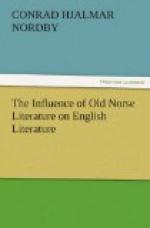(P. 168.)
From Penrose he quotes such lines as these:
The feast begins,
the skull goes round,
Laughter shouts—the
shouts resound.
The gust of war subsides—E’en
now
The grim chief
curls his cheek, and smooths his rugged brow.
(P. 171.)
From Sterling comes this imitation of Gray:
Now the rage of combat burns,
Haughty chiefs
on chiefs lie slain;
The battle glows and sinks
by turns,
Death and carnage
load the plain.
(P 172.)
From these extracts, it appears that the poets who imitated Gray considered that only “dreadful songs,” like his, were to be found in Scandinavian poetry.
Downman, Herbert and Mathias are also adduced by Dr. Drake as examples of poets who have gained much by Old Norse borrowings, but these borrowings are invariably scenes from a chamber of horrors. It occurs to me that perhaps Dr. Drake had begun to tire of the spiritless echoes of the classical schools, and that he fondly hoped that such shrieks and groans as those he admired in this essay would satisfy his cravings for better things in poetry. But the critic had no adequate knowledge of the way in which genius works. His one desire in these studies of Scandinavian mythology was “to recommend it to the votaries of the Muse, as a machinery admirably constructed for their purpose” (p. 158). He hopes for “a more extensive adoption of the Scandinavian mythology, especially in our epic and lyric compositions” (p. 311). We smile at the notion, to-day, but that very conception of poetry as “machinery” is characteristic of a whole century of our English literature.
The Mathias mentioned by Drake is Thomas James Mathias, whose book, Odes Chiefly from the Norse Tongue (London, 1781), received the distinction of an American reprint (New York, 1806). Bartholinus furnishes the material and Gray the spirit for these pieces.
AMOS S. COTTLE(1768-1800). WILLIAM HERBERT (1778-1847).
In this period belong two works of translation that mark the approach of the time when Old Norse prose and poetry were to be read in the original. As literature they are of little value, and they had but slight influence on succeeding writers.
At Bristol, in 1797, was published Icelandic Poetry, or, The Edda of Saemund translated into English Verse, by A.S. Cottle of Magdalen College, Cambridge. This work has an Introduction containing nothing worth discussing here, and an “Epistle” to A.S. Cottle from Robert Southey. The laureate, in good blank verse, discourses on the Old Norse heroes whom he happens to know about. They are the old favorites, Regner Lodbrog and his sons; in Southey’s poem the foeman’s skull is, as usual, the drinking cup. It was certainly time for new actors and new properties to appear in English versions of Scandinavian stories.




